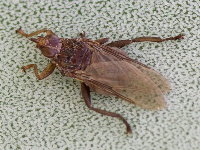Phylum Arthropoda (Arthropods) ➔ Subphylum Hexapoda (Hexapods) ➔ Class Insecta (Insects) ➔ Order Diptera (True flies) ➔ Family Hippoboscidae (Louse flies, keds)
Pseudolynchia canariensis (Macquart, 1840)
Taubenlausfliege Pigeon Louse Fly
Synonyms and other combinations:
Lynchia simillima Speiser, 1904 | Olfersia capensis Bigot, 1885 | Olfersia exornata Speiser, 1900 | Olfersia falcinelli Rondani, 1879 | Olfersia lividicolor Bigot, 1885 | Olfersia maura Bigot, 1885 | Olfersia rufipes Macquart, 1847 | Olfersia testacea Macquart, 1843 |
Further vernacular names:
Pigeon FlyClassification:
Pseudolynchia canariensis belongs to the subfamily Ornithomyinae.Distribution and Habitat:
In wide parts of the world (preferably in warmer subtropical and tropical areas) where birds (usually pigeons and doves) live which are suitable as hosts.Description:
The Pigeon Louse Fly is a dark brown fly with a flattened body and transparent well developed wings. The legs are equipped with strong femora. There are 4 claws on each foot. The males have a body length of 5 - 6 mm. At least the "pregnant" females should be a bit bigger.Biology:
The Pigeon Louse Fly Pseudolynchia canariensis is an ectoparasite of birds, often of pigeons and doves (family Columbidae).Pseudolynchia canariensis is viviparous. A female can produce 10 - 20 larvae one after the other in the course of her life. A single egg develops in the uterus of the female. After hatching, the larva remains in the mother's body and feeds on secretions. It grows and skins itself twice. At birth, the larva is fully grown and immediately ready for pupation (pre-pupa). The initially white pre-pupa hardens and forms a dark puparium. After complete metamorphosis, a young louse fly leaves the puparium.
The pupae are to be found usually at the roosting sites or in the plumage of the birds.
Note:
Pseudolynchia canariensis is known as a vector of protozoa (Haemoproteus columbae), which can cause diseases in pigeons.The Pigeon Louse Flies contribute to the spread of mites and lice as they are often used by them as a means of transport (phoresis). Passengers will drop off as soon as they have found a suitable host.
References, further reading, links:
- Pape T. & Thompson F.C. (eds) (2017). Systema Dipterorum (version 2.0, Jan 2011). In: Species 2000 & ITIS Catalogue of Life, 2017 Annual Checklist (Roskov Y., Abucay L., Orrell T., Nicolson D., Bailly N., Kirk P.M., Bourgoin T., DeWalt R.E., Decock W., De Wever A., Nieukerken E. van, Zarucchi J., Penev L., eds.). Digital resource at www.catalogueoflife.org/annual-checklist/2017. Species 2000: Naturalis, Leiden, the Netherlands. ISSN 2405-884X.
- https://wiki.nus.edu.sg/display/TAX/Pseudolynchia+canariensis+-+Pigeon+Fly
- Online-Key: Northwestern European Hippoboscidae
